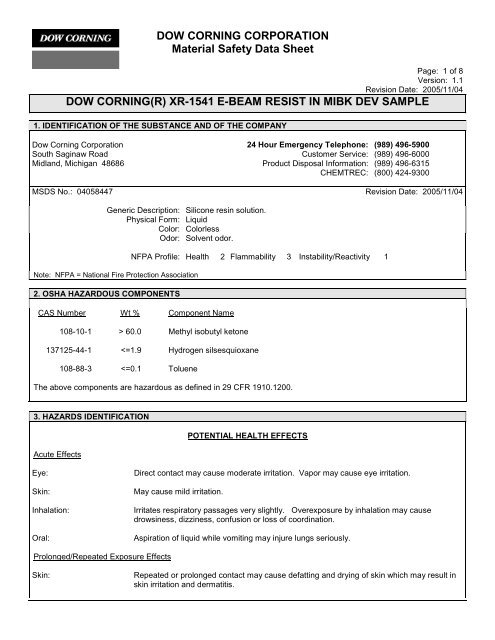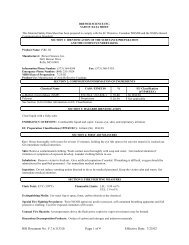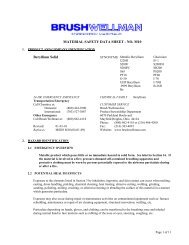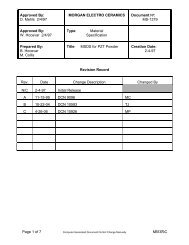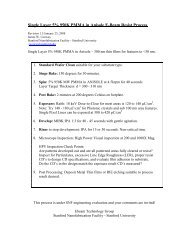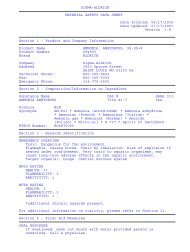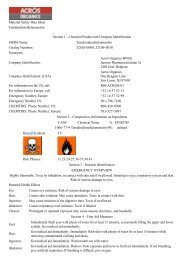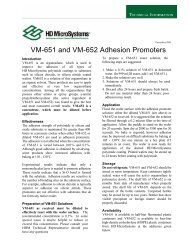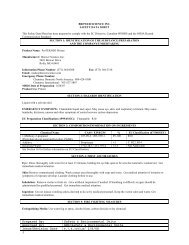DOW CORNING CORPORATION Material Safety Data Sheet DOW CORNING(R ...
DOW CORNING CORPORATION Material Safety Data Sheet DOW CORNING(R ...
DOW CORNING CORPORATION Material Safety Data Sheet DOW CORNING(R ...
Create successful ePaper yourself
Turn your PDF publications into a flip-book with our unique Google optimized e-Paper software.
<strong>DOW</strong> <strong>CORNING</strong> <strong>CORPORATION</strong><br />
<strong>Material</strong> <strong>Safety</strong> <strong>Data</strong> <strong>Sheet</strong><br />
Page: 1 of 8<br />
Version: 1.1<br />
Revision Date: 2005/11/04<br />
<strong>DOW</strong> <strong>CORNING</strong>(R) XR-1541 E-BEAM RESIST IN MIBK DEV SAMPLE<br />
1. IDENTIFICATION OF THE SUBSTANCE AND OF THE COMPANY<br />
Dow Corning Corporation<br />
South Saginaw Road<br />
Midland, Michigan 48686<br />
MSDS No.: 04058447<br />
Generic Description: Silicone resin solution.<br />
Physical Form: Liquid<br />
Color: Colorless<br />
Odor: Solvent odor.<br />
NFPA Profile:<br />
Note: NFPA = National Fire Protection Association<br />
2. OSHA HAZARDOUS COMPONENTS<br />
CAS Number Wt % Component Name<br />
108-10-1 > 60.0 Methyl isobutyl ketone<br />
137125-44-1
Inhalation:<br />
Oral:<br />
<strong>DOW</strong> <strong>CORNING</strong> <strong>CORPORATION</strong><br />
<strong>Material</strong> <strong>Safety</strong> <strong>Data</strong> <strong>Sheet</strong><br />
Page: 2 of 8<br />
Version: 1.1<br />
Revision Date: 2005/11/04<br />
<strong>DOW</strong> <strong>CORNING</strong>(R) XR-1541 E-BEAM RESIST IN MIBK DEV SAMPLE<br />
Signs and Symptoms of Overexposure<br />
No known applicable information.<br />
Medical Conditions Aggravated by Exposure<br />
No known applicable information.<br />
Overexposure by inhalation may injure the following organ(s): Lungs. Nervous system.<br />
Kidneys. Liver.<br />
Repeated ingestion or swallowing large amounts may injure internally.<br />
The above listed potential effects of overexposure are based on actual data, results of studies performed upon similar compositions,<br />
component data and/or expert review of the product. Please refer to Section 11 for the detailed toxicology information.<br />
4. FIRST AID MEASURES<br />
Eye:<br />
Immediately flush with water for 15 minutes. Get medical attention.<br />
Skin: Remove from skin and wash thoroughly with soap and water or waterless cleanser. Get<br />
medical attention if irritation or other ill effects develop or persist.<br />
Inhalation: Remove to fresh air. Get medical attention if ill effects persist.<br />
Oral: Get immediate medical attention. Only induce vomiting at the instructions of a physician.<br />
Never give anything by mouth to an unconscious person.<br />
Comments: Treat according to person's condition and specifics of exposure.<br />
5. FIRE FIGHTING MEASURES<br />
Flash Point:<br />
Autoignition Temperature:<br />
Flammability Limits in Air:<br />
Extinguishing Media:<br />
Fire Fighting Measures:<br />
Unusual Fire Hazards:<br />
62.6 °F / 17 °C (Closed Cup)<br />
Not determined.<br />
Not determined.<br />
Hazardous Decomposition Products<br />
On large fires use dry chemical, foam or water spray. On small fires use carbon dioxide<br />
(CO2), dry chemical or water spray. Water can be used to cool fire exposed containers.<br />
Self-contained breathing apparatus and protective clothing should be worn in fighting large<br />
fires involving chemicals. Determine the need to evacuate or isolate the area according to<br />
your local emergency plan. Use water spray to keep fire exposed containers cool.<br />
Vapors are heavier than air and may travel to a source of ignition and flash back. Static<br />
electricity will accumulate and may ignite vapors. Prevent a possible fire hazard by bonding<br />
and grounding or inert gas purge.
<strong>DOW</strong> <strong>CORNING</strong> <strong>CORPORATION</strong><br />
<strong>Material</strong> <strong>Safety</strong> <strong>Data</strong> <strong>Sheet</strong><br />
Page: 3 of 8<br />
Version: 1.1<br />
Revision Date: 2005/11/04<br />
<strong>DOW</strong> <strong>CORNING</strong>(R) XR-1541 E-BEAM RESIST IN MIBK DEV SAMPLE<br />
Thermal breakdown of this product during fire or very high heat conditions may evolve the following hazardous<br />
decomposition products: Carbon oxides and traces of incompletely burned carbon compounds. Formaldehyde. Silicon<br />
dioxide. Hydrogen.<br />
6. ACCIDENTAL RELEASE MEASURES<br />
Containment/Clean up:<br />
Remove possible ignition sources. Determine whether to evacuate or isolate the area<br />
according to your local emergency plan. Observe all personal protection equipment<br />
recommendations described in Sections 5 and 8. For large spills, provide diking or other<br />
appropriate containment to keep material from spreading. If diked material can be pumped,<br />
store recovered material in appropriate container. <strong>Material</strong>s in contact with water, moisture,<br />
acids or bases have the potential to generate hydrogen gas. Recovered material should be<br />
stored in a vented container. Clean up remaining materials from spill with suitable absorbant.<br />
Clean area as appropriate since spilled materials, even in small quantities, may present a slip<br />
hazard. Final cleaning may require use of steam, solvents or detergents. Dispose of<br />
saturated absorbant or cleaning materials appropriately, since spontaneous heating may<br />
occur. Local, state and federal laws and regulations may apply to releases and disposal of<br />
this material, as well as those materials and items employed in the cleanup of releases. You<br />
will need to determine which federal, state and local laws and regulations are applicable.<br />
Sections 13 and 15 of this MSDS provide information regarding certain federal and state<br />
requirements.<br />
Note: See section 8 for Personal Protective Equipment for Spills. Call (989) 496-5900, if additional information is<br />
required.<br />
7. HANDLING AND STORAGE<br />
Use with adequate ventilation. Avoid eye exposure. Avoid skin contact. Avoid breathing vapor, mist, dust, or fumes.<br />
Keep container closed. Do not take internally.<br />
Static electricity will accumulate and may ignite vapors. Prevent a possible fire hazard by bonding and grounding or inert<br />
gas purge. Keep container closed and away from heat, sparks, and flame. Product evolves minute quantities of<br />
flammable hydrogen gas which can accumulate. Adequately ventilate to maintain vapors well below flammability limits<br />
and exposure guidelines. Do not repackage. Do not store in glass containers which may shatter due to pressure build up.<br />
Clogged container vents may increase pressure build up. Keep container closed and store away from water or moisture.<br />
8. EXPOSURE CONTROLS / PERSONAL PROTECTION<br />
Component Exposure Limits<br />
CAS Number Component Name<br />
108-10-1 Methyl isobutyl ketone<br />
Engineering Controls<br />
Exposure Limits<br />
OSHA PEL (final rule): TWA 100 ppm and ACGIH TLV:<br />
TWA 50 ppm, STEL 75 ppm.
<strong>DOW</strong> <strong>CORNING</strong> <strong>CORPORATION</strong><br />
<strong>Material</strong> <strong>Safety</strong> <strong>Data</strong> <strong>Sheet</strong><br />
Page: 4 of 8<br />
Version: 1.1<br />
Revision Date: 2005/11/04<br />
<strong>DOW</strong> <strong>CORNING</strong>(R) XR-1541 E-BEAM RESIST IN MIBK DEV SAMPLE<br />
Local Ventilation: Recommended.<br />
General Ventilation: Recommended.<br />
Personal Protective Equipment for Routine Handling<br />
Eyes:<br />
Skin:<br />
Suitable Gloves:<br />
Inhalation:<br />
Suitable Respirator:<br />
Personal Protective Equipment for Spills<br />
Eyes:<br />
Skin:<br />
Inhalation/Suitable<br />
Respirator:<br />
Use chemical worker's goggles.<br />
Wash at mealtime and end of shift. Contaminated clothing and shoes should be removed as<br />
soon as practical and thoroughly cleaned before reuse. Chemical protective gloves are<br />
recommended.<br />
Polyvinylalcohol. Teflon(R). Butyl Rubber. Nitrile Rubber.<br />
Use respiratory protection unless adequate local exhaust ventilation is provided or exposure<br />
assessment demonstrates that exposures are within recommended exposure guidelines. IH<br />
personnel can assist in judging the adequacy of existing engineering controls.<br />
General and local exhaust ventilation is recommended to maintain vapor exposures below<br />
recommended limits. Where concentrations are above recommended limits or are unknown,<br />
appropriate respiratory protection should be worn. Follow OSHA respirator regulations (29<br />
CFR 1910.134) and use NIOSH/MSHA approved respirators.<br />
Use full face respirator.<br />
Wash at mealtime and end of shift. Contaminated clothing and shoes should be removed as<br />
soon as practical and thoroughly cleaned before reuse. Chemical protective gloves are<br />
recommended.<br />
Respiratory protection recommended. Follow OSHA Respirator Regulations (29 CFR<br />
1910.134) and use NIOSH/MHSA approved respirators. Protection provided by air purifying<br />
respirators against exposure to any hazardous chemical is limited. Use a positive pressure air<br />
supplied respirator if there is any potential for uncontrolled release, exposure levels are<br />
unknown, or any other circumstance where air purifying respirators may not provide adequate<br />
protection.<br />
Precautionary Measures: Avoid eye exposure. Avoid skin contact. Avoid breathing vapor, mist, dust, or fumes. Keep<br />
container closed. Do not take internally. Use reasonable care.<br />
Note: These precautions are for room temperature handling. Use at elevated temperature or aerosol/spray applications may require<br />
added precautions. For further information regarding aerosol inhalation toxicity, please refer to the guidance document regarding the<br />
use of silicone-based materials in aerosol applications that has been developed by the silicone industry (www.SEHSC.com) or contact<br />
the Dow Corning customer service group.<br />
9. PHYSICAL AND CHEMICAL PROPERTIES<br />
Physical Form: Liquid<br />
Color: Colorless<br />
Odor: Solvent odor.<br />
Specific Gravity @ 25°C: 0.8
<strong>DOW</strong> <strong>CORNING</strong> <strong>CORPORATION</strong><br />
<strong>Material</strong> <strong>Safety</strong> <strong>Data</strong> <strong>Sheet</strong><br />
Page: 5 of 8<br />
Version: 1.1<br />
Revision Date: 2005/11/04<br />
<strong>DOW</strong> <strong>CORNING</strong>(R) XR-1541 E-BEAM RESIST IN MIBK DEV SAMPLE<br />
Viscosity: 0.6 cSt<br />
Freezing/Melting Point: Not determined.<br />
Boiling Point: > 35C/95F<br />
Vapor Pressure @ 25°C: Not determined.<br />
Vapor Density: Not determined.<br />
Solubility in Water: Not determined.<br />
pH: Not determined.<br />
Volatile Content: Not determined.<br />
Note: The above information is not intended for use in preparing product specifications. Contact Dow Corning before writing<br />
specifications.<br />
10. STABILITY AND REACTIVITY<br />
Chemical Stability:<br />
Hazardous<br />
Polymerization:<br />
Conditions to Avoid:<br />
Stable.<br />
Hazardous polymerization will not occur.<br />
None.<br />
<strong>Material</strong>s to Avoid: Oxidizing material can cause a reaction. Water, alcohols, acidic or basic materials, and many<br />
metals or metallic compounds, when in contact with product, liberate flammable hydrogen<br />
gas, which can form explosive mixtures in air.<br />
11. TOXICOLOGICAL INFORMATION<br />
Component Toxicology Information<br />
A material containing 94% hydrogen silsesquioxane was evaluated for acute inhalation toxicity in two groups of five male<br />
and five female albino rats. Whole body exposures were for four hours to dust aerosol atmospheres at a concentration of<br />
either 8.2 or 1.3 mg/L. All but one male died either during the exposure to 8.2 mg/L or by the first day post-exposure.<br />
Exposure related macroscopic abnormalities were noted in the trachea, lungs and liver. None of the animals exposed to<br />
1.3 mg/L died or exhibited exposure related abnormalities at necropsy. Therefore, the 4-hour LC50 for the test material is<br />
greater than 1.3 mg/L but less than 8.2 mg/L.<br />
Special Hazard Information on Components<br />
No known applicable information.<br />
12. ECOLOGICAL INFORMATION<br />
Environmental Fate and Distribution<br />
Complete information is not yet available.<br />
Environmental Effects
<strong>DOW</strong> <strong>CORNING</strong> <strong>CORPORATION</strong><br />
<strong>Material</strong> <strong>Safety</strong> <strong>Data</strong> <strong>Sheet</strong><br />
Page: 6 of 8<br />
Version: 1.1<br />
Revision Date: 2005/11/04<br />
<strong>DOW</strong> <strong>CORNING</strong>(R) XR-1541 E-BEAM RESIST IN MIBK DEV SAMPLE<br />
Complete information is not yet available.<br />
Fate and Effects in Waste Water Treatment Plants<br />
Complete information is not yet available.<br />
Ecotoxicity Classification Criteria<br />
Hazard Parameters (LC50 or EC50) High Medium Low<br />
Acute Aquatic Toxicity (mg/L) 1 and 100<br />
Acute Terrestrial Toxicity 100 and 2000<br />
This table is adapted from "Environmental Toxicology and Risk Assessment", ASTM STP 1179, p.34, 1993.<br />
This table can be used to classify the ecotoxicity of this product when ecotoxicity data is listed above. Please read the other information presented in the<br />
section concerning the overall ecological safety of this material.<br />
13. DISPOSAL CONSIDERATIONS<br />
RCRA Hazard Class (40 CFR 261)<br />
When a decision is made to discard this material, as received, is it classified as a hazardous waste? NOT ASSESSED<br />
State or local laws may impose additional regulatory requirements regarding disposal.<br />
Call (989) 496-6315, if additional information is required.<br />
14. TRANSPORT INFORMATION<br />
DOT Road Shipment Information (49 CFR 172.101)<br />
Proper Shipping Name: Methyl isobutyl ketone Solution<br />
Hazard Class: 3<br />
UN/NA Number: UN 1245<br />
Packing Group: II<br />
Hazard Label(s): Flammable Liquid<br />
Ocean Shipment (IMDG)<br />
Proper Shipping Name: METHYL ISOBUTYL KETONE Solution<br />
Hazard Class: 3<br />
UN/NA Number: UN 1245<br />
Packing Group: II<br />
Hazard Label(s): flammable liquid
<strong>DOW</strong> <strong>CORNING</strong> <strong>CORPORATION</strong><br />
<strong>Material</strong> <strong>Safety</strong> <strong>Data</strong> <strong>Sheet</strong><br />
Page: 7 of 8<br />
Version: 1.1<br />
Revision Date: 2005/11/04<br />
<strong>DOW</strong> <strong>CORNING</strong>(R) XR-1541 E-BEAM RESIST IN MIBK DEV SAMPLE<br />
Air Shipment (IATA)<br />
Proper Shipping Name: Methyl isobutyl ketone Solution<br />
Hazard Class: 3<br />
UN/NA Number: UN 1245<br />
Packing Group: II<br />
Hazard Class: Flammable Liquid<br />
Remarks: VENTED PACKAGES ARE FORBIDDEN FOR AIR TRANSPORT.<br />
Call Dow Corning Transportation, (989) 496-8577, if additional information is required.<br />
15. REGULATORY INFORMATION<br />
Contents of this MSDS comply with the OSHA Hazard Communication Standard 29 CFR 1910.1200.<br />
TSCA Status: All chemical substances in this material are included on or exempted from listing on the TSCA<br />
Inventory of Chemical Substances.<br />
EPA SARA Title III Chemical Listings<br />
Section 302 Extremely Hazardous Substances (40 CFR 355):<br />
None.<br />
Section 304 CERCLA Hazardous Substances (40 CFR 302):<br />
CAS Number Wt % Component Name<br />
108-10-1 98.0 Methyl isobutyl ketone<br />
108-88-3
<strong>DOW</strong> <strong>CORNING</strong> <strong>CORPORATION</strong><br />
<strong>Material</strong> <strong>Safety</strong> <strong>Data</strong> <strong>Sheet</strong><br />
Page: 8 of 8<br />
Version: 1.1<br />
Revision Date: 2005/11/04<br />
<strong>DOW</strong> <strong>CORNING</strong>(R) XR-1541 E-BEAM RESIST IN MIBK DEV SAMPLE<br />
Supplemental State Compliance Information<br />
California<br />
Warning: This product contains the following chemical(s) listed by the State of California under the Safe Drinking Water<br />
and Toxic Enforcement Act of 1986 (Proposition 65) as being known to cause cancer, birth defects or other<br />
reproductive harm.<br />
CAS Number<br />
Wt %<br />
108-88-3 60.0 Methyl isobutyl ketone<br />
New Jersey<br />
CAS Number<br />
Wt %<br />
Component Name<br />
108-10-1 > 60.0 Methyl isobutyl ketone<br />
137125-44-1 60.0 Methyl isobutyl ketone<br />
16. OTHER INFORMATION<br />
Prepared by: Dow Corning Corporation<br />
Developmental toxin.<br />
These data are offered in good faith as typical values and not as product specifications. No warranty, either expressed or<br />
implied, is hereby made. The recommended industrial hygiene and safe handling procedures are believed to be generally<br />
applicable. However, each user should review these recommendations in the specific context of the intended use and<br />
determine whether they are appropriate.<br />
(R) indicates Registered Trademark


